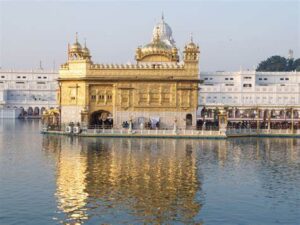The Golden Temple: A Spiritual Gem of Punjab

Introduction
Nestled in the heart of Amritsar, Punjab, the Golden Temple, also known as Sri Harmandir Sahib, is not just a place of worship but a symbol of the Sikh faith, spirituality, and community service. Adorned with shimmering gold, this architectural marvel stands as a beacon of peace, equality, and unity for people from all walks of life. This blog aims to explore the historical significance, architectural beauty, spiritual essence, and visitor experience of the Golden Temple.
Historical Significance
Foundation and Construction
The foundation of the Golden Temple was laid by Guru Ram Das, the fourth Guru of Sikhism, in 1581. The construction was completed by Guru Arjan Dev, the fifth Guru, in 1604. Over the centuries, the temple has undergone various renovations and expansions, including the addition of its distinctive golden exterior under Maharaja Ranjit Singh in the early 19th century.
Symbol of Resilience
The Golden Temple has withstood numerous invasions and attacks throughout its history, each time being rebuilt by the Sikh community with unwavering dedication. These challenges have only strengthened the temple’s significance as a symbol of Sikh resilience, spirituality, and selfless service.
Architectural Marvel
Golden Façade
The most striking feature of the Golden Temple is its gilded exterior, which is covered with approximately 750 kilograms of pure gold. The gold-plated structure stands in the middle of a sarovar (holy pool), creating a mesmerizing reflection that is particularly breathtaking during sunrise and sunset.
Sarovar (Holy Pool)
Surrounding the temple is the Amrit Sarovar, or Pool of Nectar, which is fed by the sacred Amrit Saras (spring of immortality). Pilgrims believe that bathing in these holy waters cleanses the soul and brings spiritual purification.
Sanctum Sanctorum
In the heart of the Golden Temple complex lies the sanctum sanctorum, housing the Guru Granth Sahib, the holy scripture of Sikhism. The Guru Granth Sahib is placed under a canopy known as the Palki Sahib and is read continuously by appointed priests and volunteers.
Intricate Architecture
The temple’s architecture is a blend of Hindu and Islamic styles, reflecting the inclusive and diverse ethos of Sikhism. The lower levels of the temple are adorned with marble inlay work, while the upper floors are covered in gold foil. The entire structure is topped with a gilded dome and pinnacle, symbolizing the Sikh commitment to spiritual and material aspirations.
Spiritual Essence
Principles of Sikhism
The Golden Temple embodies the core principles of Sikhism, including equality, humility, and selfless service. One of the most powerful demonstrations of these principles is the langar, or community kitchen, which serves free meals to all visitors regardless of their religion, caste, or social status.
Langar (Community Kitchen)
The langar at the Golden Temple is one of the largest community kitchens in the world, serving over 100,000 meals on busy days. Volunteers work tirelessly to prepare, serve, and clean up after meals, ensuring that everyone who visits the temple is well-fed and cared for.
Gurdwara Protocols
Visitors to the Golden Temple are required to cover their heads, remove their shoes, and wash their feet before entering the main temple complex. Modest clothing is recommended out of respect for the sanctity of the site.
Visitor Experience
Cultural Experience
A visit to the Golden Temple offers a unique cultural experience, allowing visitors to witness Sikh traditions and rituals firsthand. The atmosphere is both peaceful and vibrant, with the sound of hymns (kirtan) echoing through the complex.
Festivals and Celebrations
The Golden Temple celebrates several Sikh festivals with great enthusiasm, including Guru Nanak Jayanti, Vaisakhi, and Diwali. During these times, the temple is illuminated with thousands of lights, creating a magical and festive ambiance.
Practical Tips
- Timing: The Golden Temple is open to visitors 24 hours a day, seven days a week.
- Photography: Photography is allowed in most areas of the complex, but it is prohibited inside the sanctum sanctorum.
- Donations: Visitors are welcome to make donations to support the langar and other charitable initiatives of the temple.
- Respect: Visitors should maintain a respectful demeanor at all times, refraining from smoking, drinking alcohol, or engaging in any disruptive behavior.
Nearby Attractions
Jallianwala Bagh
Located a short distance from the Golden Temple, Jallianwala Bagh is a historic public garden that commemorates the Jallianwala Bagh massacre of 1919. The garden houses a memorial and museum dedicated to the martyrs.
Partition Museum
The Partition Museum in Amritsar is a poignant reminder of the human cost of the partition of India in 1947. The museum houses personal stories, photographs, and artifacts from that tumultuous period in history.
Wagah Border Ceremony
The Wagah Border, about 30 kilometers from Amritsar, is famous for its daily evening ceremony where the flags of India and Pakistan are lowered in a highly choreographed display of patriotism and military tradition.
Conclusion
The Golden Temple is more than just a religious site; it is a spiritual and cultural marvel that captivates the hearts of millions of visitors each year. Its gleaming façade, serene sarovar, and welcoming atmosphere make it a must-visit destination for anyone seeking to experience the rich traditions and values of Sikhism. As you walk through its hallowed halls, partake in the langar, and witness the timeless rituals, the Golden Temple promises to leave a lasting impression of peace, harmony, and unity in diversity. It truly stands as a radiant symbol of faith, humanity, and the universal spirit of love and compassion.
